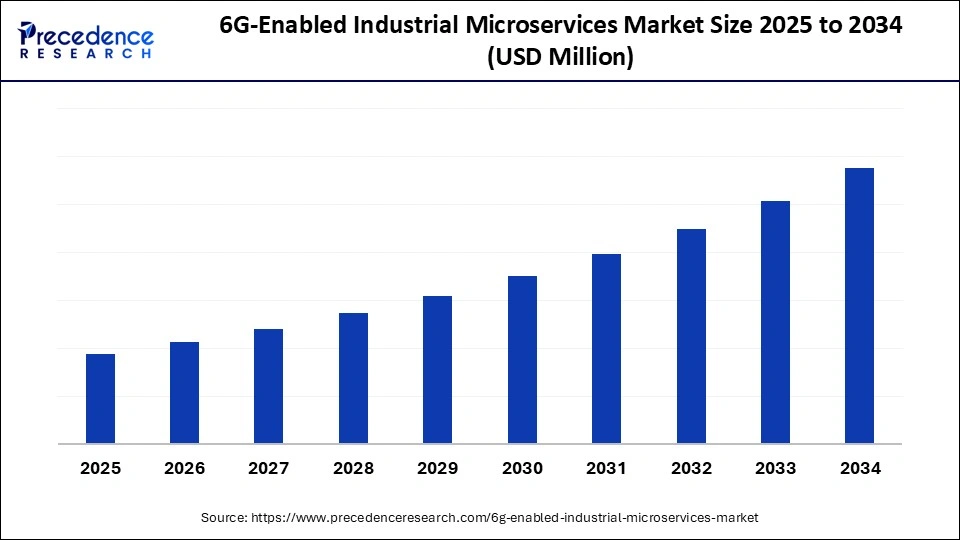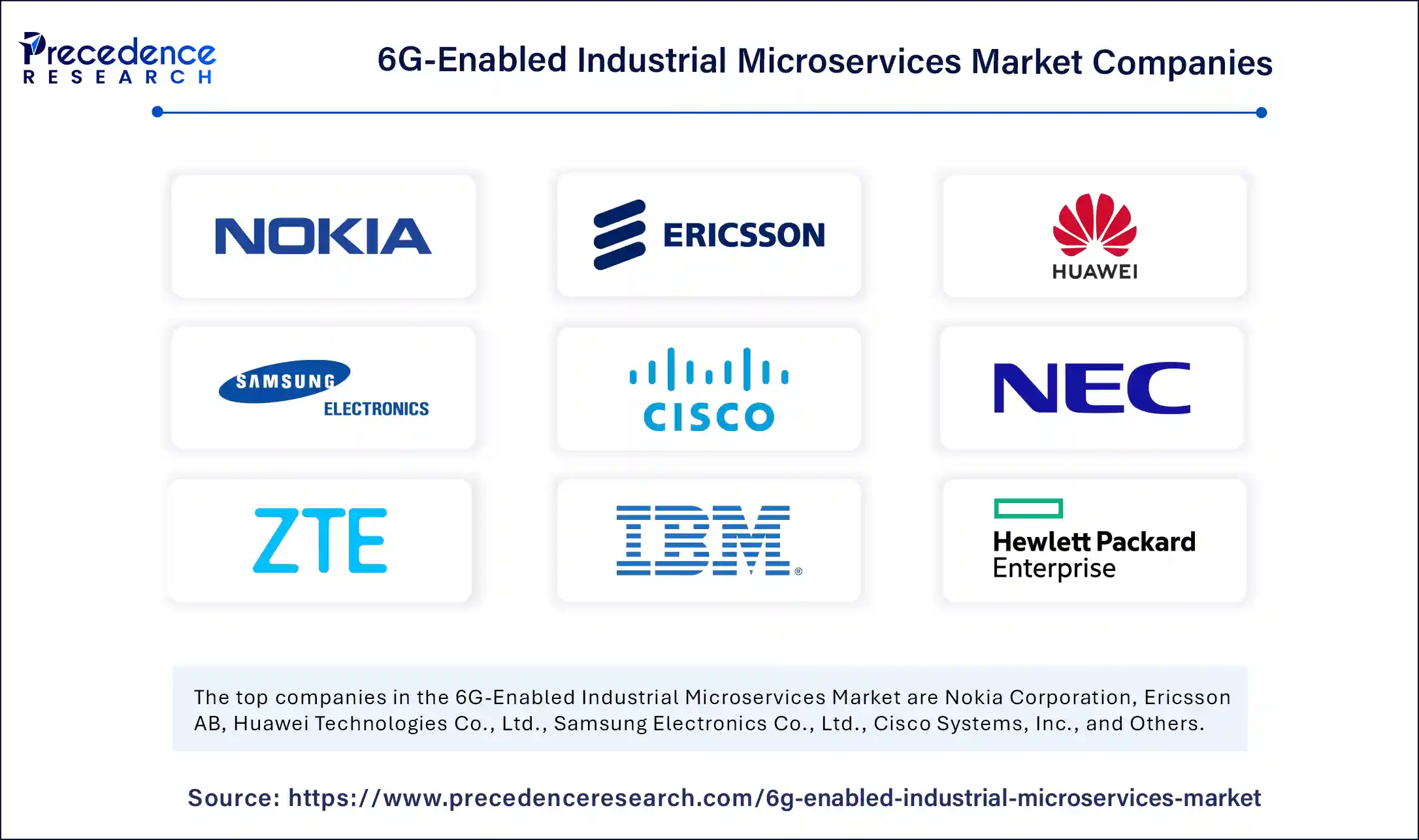6G-Enabled Industrial Microservices Market Set to Soar: Global Valuation to Surpass Billions by 2034
6G-Enabled Industrial Microservices Market Size and Forecast 2025 to 2034
Ultra-Low Latency, AI, and Smart Factories Fuel Unprecedented Market Expansion Worldwide
Industrial Microservices + 6G: The Next-Gen Automation Breakthrough
The global 6G-enabled industrial microservices market is poised for explosive growth, forecast to surge at a robust CAGR through 2034, driven by convergence of edge computing, AI, and next-gen connectivity across smart factories and advanced automation environments.
With North America currently leading the charge and Asia Pacific emerging as the fastest-growing region the market stands at the forefront of a technological revolution, ushering in new levels of operational efficiency, scalability, and intelligent automation. Key forces include Industry 4.0 adoption, ultra-high speeds, and the need for modular, resilient software architectures in complex industrial ecosystems.

6G-Enabled Industrial Microservices Market Key Insights
-
North America commands the largest market share, thanks to extensive Industry 4.0 adoption and massive R&D investments.
-
Asia Pacific is projected as the fastest-growing region, fueled by surging smart factories, government support, and rising urbanization.
-
The platforms & frameworks segment—enabling cloud-native service mesh orchestration—dominated in 2024.
-
Large enterprises are at the forefront, leveraging 6G to integrate devices, boost real-time automation, and power digital twins at scale.
-
Cloud-based architectures represent the largest deployment model, optimizing logistics and manufacturing applications worldwide.
-
The fastest-growing applications include digital twins and simulation, enabled by real-time analytics and AI-driven automation.
Table: Regional Revenue and Growth Highlights
| Region | Status | Key Drivers |
|---|---|---|
| North America | Dominant | Industry 4.0, tech ecosystem, federal support, R&D |
| Asia Pacific | Fastest Growing | Urbanization, smart automation, AI/ML, edge computing |
| Europe | Significant Share | Industrial IoT adoption, digital twins, automation |
| Latin America | Emerging | Infrastructure upgrades, manufacturing digitization |
| Middle East & Africa | Emerging | Regional smart factory pilots, connectivity improvements |
Artificial Intelligence (AI) sits at the heart of the 6G-enabled industrial microservices revolution. Machine learning algorithms process vast rivers of IIoT sensor data to predict failures, optimize maintenance, and dynamically allocate resources in real time—creating smarter, safer, and more resilient industrial networks. As AI integrates with next-gen 6G connectivity, it empowers rapid operational adjustments, from predictive analytics to autonomous system controls. Add quantum-resistant security and coordinated threat detection, and industries gain unparalleled protection for sensitive data and infrastructure, particularly in finance and healthcare.
Industry experts highlight that, over the next decade, the marriage of AI and 6G networks will underpin everything from holographic communications in logistics to real-time digital twins in advanced manufacturing. “AI-native networking, combined with low-latency 6G, will fundamentally reshape industrial automation and decision-making,” notes Precedence Research Principal Consultant, Dr. Richa Menon.
What Drives Market Growth in 6G-Enabled Microservices?
Why are ultra-high speeds and low latency vital for industrial automation?
Unprecedented speeds and latency under one microsecond enable real-time data processing, human-robot interfaces, and precise control over machinery and autonomous systems.
How do smart factories accelerate demand for 6G microservices?
Smart factories thrive on hyper-connectivity and actionable insights from IoT devices. The agility of 6G-enabled microservices improves predictive maintenance and resource management, reducing downtime and costs.
What makes platforms & frameworks stand out in the current market?
Cloud-native platforms—integrating service mesh and orchestration—manage the complex communications among modular microservices, ensuring seamless deployment and enhanced security.
How will small and medium enterprises (SMEs) benefit going forward?
SMEs can deploy 6G microservices swiftly to scale their automation solutions, extracting real-time data insights and competing with much larger organizations on the digital playing field.
6G-Enabled Industrial Microservices Market Opportunities & Trends
What emerging trends should market leaders watch?
Hybrid and edge-cloud integration remains the hottest trend, allowing on-premise control with cloud scalability and real-time process improvements.
Which application segments are in the spotlight?
Smart manufacturing, digital twins, and simulation ranked as top growth areas, leveraging ultra-fast connectivity for predictive maintenance and complex analytics.
What breakthrough innovations are driving transformation?
The rise of quantum-resistant encryption, AI-driven orchestration, and human-machine interfaces (such as holographic communication) mark the next wave of breakthroughs in industrial settings.
6G-Enabled Industrial Microservices Market Segmentation
Components
-
Platforms & frameworks led the market in 2024, powering orchestration and resource management.
-
Service providers are racing to roll out consulting, integration, maintenance, and managed services focused on ultra-reliable 6G network solutions.
Deployment Models
-
Cloud-based models command the highest adoption, optimizing operations for global manufacturers and logistics providers.
-
Edge-cloud integration is the fastest-growing model, enabling granular control and real-time responsiveness in industrial automation.
Enterprise Size
-
Large enterprises dominate, but SMEs are rapidly entering the fold due to easier integration and cost-effective 6G-enabled solutions.
Applications
-
Smart manufacturing and industrial automation remain pillars of market demand, with digital twins and simulation seeing record growth rates.
6G-Enabled Industrial Microservices Market Regional Analysis
-
North America retains its dominant position, spurred by tech innovation and supportive policy environments.
-
Asia Pacific leads in growth, catalyzed by smart factories, IoT adoption, and urban industrial transformation.
6G-Enabled Industrial Microservices Market Companies

- Nokia Corporation
- Ericsson AB
- Huawei Technologies Co., Ltd.
- Samsung Electronics Co., Ltd.
- Cisco Systems, Inc.
- NEC Corporation
- ZTE Corporation
- IBM Corporation
- Hewlett Packard Enterprise (HPE)
- Microsoft Corporation
- Amazon Web Services (AWS)
- Google Cloud (Alphabet Inc.)
- Siemens AG
- General Electric (GE Digital)
- Schneider Electric SE
- Rockwell Automation, Inc.
- Intel Corporation
- Qualcomm Technologies, Inc.
- Fujitsu Ltd.
- Capgemini SE
Challenges and Cost Pressures Facing the Market
High infrastructure costs remain the greatest obstacle, especially in lower and middle-income countries. Significant upfront investments in 6G infrastructure can limit market expansion and slow technology adoption, even as enterprises strive to future-proof their operations.
Sample Case Study: Smart Manufacturing Transformation
A global electronics manufacturer implemented 6G-enabled microservices across its smart factory operations, leveraging AI-powered predictive maintenance and digital twins. This led to a 40% reduction in downtime and a 30% increase in overall equipment efficiency, demonstrating real-world impact and ROI in Industry 4.0 transformation.
Read Also: Enterprise Flash Storage Market
You can place an order or ask any questions. Please feel free to contact us at sales@precedenceresearch.com |+1 804 441 9344
